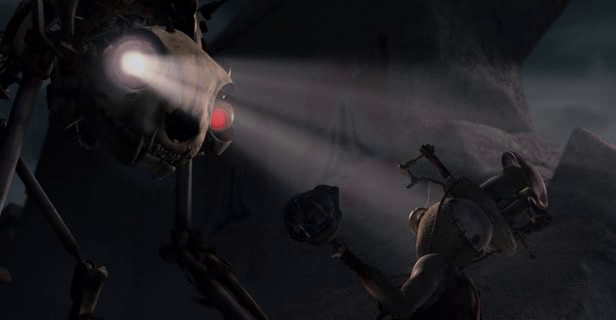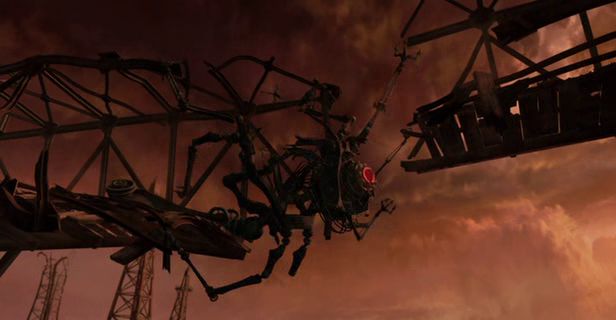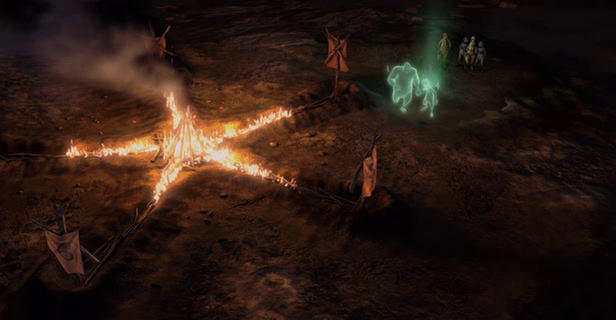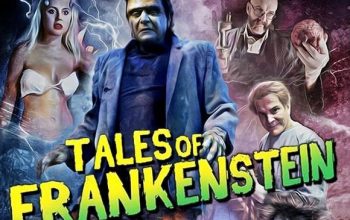9 (Movie) (2009)
9 is computer animated children’s movie, perhaps a little darker and scarier than many children’s movies but otherwise not especially memorable. The visual design is interesting but the plot is mostly runaround and the character development is negligible.

It does deal with some Frankensteinian themes (artificial intelligences, technology run amuck) but so do many sci-fi movies these days. What makes it interesting to me is a blink-and-you-miss it detail that moves the film from vaguely Frankensteinian to absolutely Frankensteinian.
9 (Elijah Wood) is a little humanoid robot, shaped like a rag doll. Immediately after his creation, his creator dies, leaving him in a little flat. 9 leaves the flat into a devastated world. There is no life anywhere to be seen, just destroyed buildings and the occasional corpse. In this world, he finds 2 (Martin Landau), another rag-doll creature, who has been searching for others of his kind. 2 is fascinated by a talisman hidden in 9’s body. However, 2 is captured by a sort of robot monster and taken away to a sinister factory.

Nine finds his way to 2’s home – a where more dolls live, ruled by the imperious and dogmatic 1 (Christopher Plummer). 1 forbids 9 from rescuing 2, but 9 convinces 5 (John C. Reilly) to come with him, and goes to the rescue. At the factory, they are joined by 7 (Jennifer Connelly), a warrior-woman ragdoll. 2 is briefly rescued, but 9 finds the place that the talisman fits, accidentally reawakening B.R.A.I.N., the AI that controls the factory. The dolls escape, but not before 2 is killed and his soul absorbed by B.R.A.I.N.
The dolls escape to the Cathedral, but B.R.A.I.N, sends its robots after them. The dolls escape again, taking refuge in a library run by the missing 3 and 4, twin archivists. The archivists explain the backstory – a Scientist (Alan Oppenheimer) created B.R.A.I.N, but his invention is co-opted by the Fascist ruler of his country. The B.R.A.I.N. was put to work building war machines to conquer the world, but then turns on the Leader and declares war on humanity. Both sides are wiped out in the conflict, while the Scientist turned his genius to creating the nine doll creatures, each containing a fragment of his own soul.

The B.R.A.I.N. creates a duplicate of 2 and uses him to infiltrate the library. In this way, he captures and absorbs other dolls. The remaining dolls battle the B.R.A.I.N. across the ruined city. The cowardly 1 redeems himself by sacrificing himself to save his friends, destroying the B.R.A.I.N. The dead ragdolls are arranged in a five pointed star (!) and a funeral ritual frees their souls. They ascend to the sky, then it begins to rain. In the raindrops are dividing cells – life begins anew.
It’s an odd little movie, is what I’m saying.
What’s interesting about this is, as I said, a blink-and-you-miss-it moment during the exposition sequence in the library. The Scientist is shown to be consulting the works of the German alchemist Paracelsus. The illustration in this manuscript directly mirrors the process by which the Scientist ensouls to the dolls. Straight away, we’re in Frankenstein territory.

In Mary Shelley’s novel, Victor Frankenstein was largely self-taught before attending the University of Ingolstadt. He reads widely, including some of the great early- and pre-scientific thinkers, including Paracelsus. I say alchemist, but it would also be true to say that he trying to figure out how to be a doctor without the aid of modern science. He said a lot of stupid things, but also had some good guesses, coming up with ideas that prefigure modern germ theory and psychoanalysis.
Oh, and he also talked about the creation of homunculi. The homunculus is an idea going back to the Middle Ages, where it’s found in both Western and Islamic thought. The idea is that through a (frankly rather gross) process you could create a living human without all that tedious ‘reproduction’ nonsense. Some thinkers seemed to think homunculi were real things, others just used them in philosophical thought experiments – would such a creature have a soul? Would it be ethical to experiment on such a creature? And so on.

In my opinion, Mary Shelley doesn’t really interest herself in whether her Monster had a soul. She’s more interested in Victor Frankenstein’s soul. Or more importantly, the lack of soul in Frankenstein’s studies. Frankenstein abandons Paracelsus and his emphasis self-knowledge and soul and turns towards Francis Bacon and his emphasis on wresting the secrets of the world from their hiding places. In practical terms, this means that he is unprepared for the emotional work of parenthood that should have followed the practical work of homunculus creation.
What does this have to do with 9? Well, in 9, the Scientist learns. He creates a soulless machine that falls into the hands of a soulless government and disaster ensues. He learns from this, he gains self-knowledge and sends his soul out into the world to fix his mistake.

This has been a theme of a lot of recent Frankenstein literature – that the bad inhuman creation will be defeated by the good, humanlike creation. Age of Ultron is a good recent example, and of course it’s arguably the basis of Blade Runner. It’s not hard to see why this should be. One of the themes of Frankenstein is that of out-of-control technology. Our technology has become so all powerful and all controlling that there’s simply no chance we can just form an angry mob and smash it all. All we can really hope is that our next creation will defeat our last creation.

So yeah, 9 is an interesting little morality play, under the surface. I’m not sure I agree with it – it’s very easy to construct arguments around the concept of the soul, because no one seems to know what one is. But I guess it’s easier to find hidden depths in this movie than it is in many other children’s versions of the Frankenstein fable.



